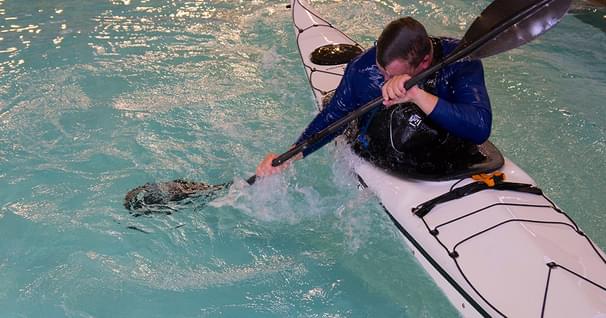Stopping SUP Board
Most people are concerned with how to get their standup paddle board moving forward, but it's just as important that you learn how to stop your board. In this segment, we're going to talk about a couple techniques that are effective for stopping your board, and also, turning your board as you stop.
The first way to stop an SUP is by using a reverse sweep or a reverse stroke. This is the easiest technique to stop your board, but by doing this, you'll end up stopping and turning your board at the same time. When you're ready to stop your board, bend your knees a little bit more, rotate to the tail, plant the blade, and push the blade away from the board. This is going to slow you down, stop you, and also turn the board 90 degrees. Something to keep in mind when you're doing this is that your board should stay as flat and quiet as possible, throughout the stroke.
A more advanced method of stopping your board involves stepping back and sinking the tail of your board to create drag in the water. The advantage is that your board doesn't need to turn while you're stopping. When we're stepping back to the tail to stop, we need to think about which foot we're going to want in front, once we do come to a stop. If you've ever been on a snowboard, skateboard, or surfboard, and you know which foot you prefer in front, go ahead and use that one. Otherwise, just pick a foot that feels the most comfortable to be the one you're going to have in front of you.
Basically, what we're going to do is take a small step back with our front foot, and then a large step back with the foot that's going to become our rear foot. When we do this, the tail sinks in the water and every board has a sweet spot. You're going to find that sweet spot where the board sinks effectively, but you still remain balanced. Speaking of balance, this is where your paddle comes in during the move. You want to keep the blade of the paddle either in the water or right on the surface of the water throughout the move. This allows you to quickly and easily brace with your paddle against the water if you start losing your balance. On that note, bracing is the topic of our next segment.
Related Articles
By changing how you edge and balance your boat you can increase your stability and adaptability. Using…
Whether you were new to paddling in 2018 or you're an experienced paddler, you can never stop learning.…
Mention “pool session” and the first image that pops into most kayakers minds is a class in how to roll.…
Photo Credit: Darlene Patterson Many people who have paddled for years can't keep a canoe on a straight…



